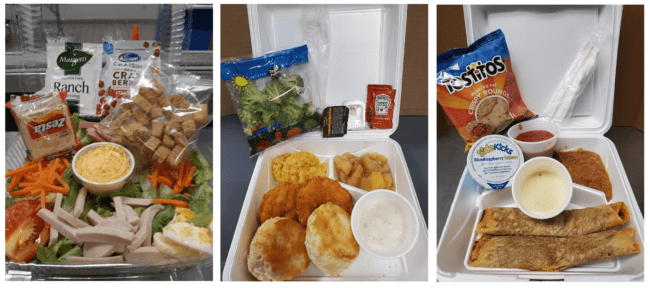
By Karen Campbell, Weakley County Communications Director
Dresden, Tenn.–Families that download the monthly menus found on their school websites may have noticed a trend lately. Student favorites like ham and cheese sliders, chicken and biscuits, and steamed cheesy broccoli are listed on the page but may not appear on the plates.
Supply chain disturbances mean the list of hard-to-find items from the beginning of the school year is getting longer.
The nationwide problem has become so severe that the USDA is now issuing waivers to allow School Nutrition Departments to adjust when the prescribed items cannot be found. But that search is required and may take hours out of the week.
The USDA guidelines for School Nutrition are very specific. Kindergarteners through 5th graders are to receive 550-650 calories per day; grades 6-8, 600-700 calories; and grades 9-12, 750-850 calories. Those calories then must be disbursed in specified amounts of fruits, vegetables (dark green, red/orange, beans and peas, starchy), grains, meats and meat alternates, and milk.
When just one of those categories become hard to come by, substitutions can be made. When the list grows to over 30 items – as it is now — waivers are a must.
“It’s not that we can’t get bread,” explained Trista Snider, director of Weakley County Schools Nutrition Department, of one of the longstanding scarcities. “It’s we can’t get the bread – 51% or more whole grain or wheat — we are supposed to serve.”
The scarcity also means an increase in costs to the cafeterias. When ketchup packets once cost 2 cents are now 4 cents, those seemingly small jumps can have a big impact.
“When you are using as many as we are, that’s a big price increase for a condiment,” Snider explained.
Snider says she has been told that the supply chain gaps are the result of a combination of manufacturing plants’ difficulty in filling open positions and manufacturers opting to produce more popular bestsellers rather than the items dictated for school nutrition.
A second national problem with school breakfasts and lunches is not hitting the Weakley County area as hard. Many school systems are experiencing labor shortages. Weakley County’s nine kitchens are currently fully staffed. However, ongoing health issues mean the need for available substitute staff is constant.
“We hope our students and their families will be patient with us,” said Snider of the changes that often translate into several hours of additional administrative focus as viable alternatives are located. “Our cafeteria managers and staff really do want to serve meals that are both tasty and nutritious. These days, we are just having to be very creative to do so.”
Photo: Examples of meals with items that are getting harder or more expensive to come by in Weakley County Schools cafeterias are salads made with romaine lettuce, chicken patties, broccoli, and ketchup. While these items are “hit and miss”, said Trista Snider, Director of School Nutrition, one very popular item – the Crispito – is no longer produced and therefore off school menus permanently.









